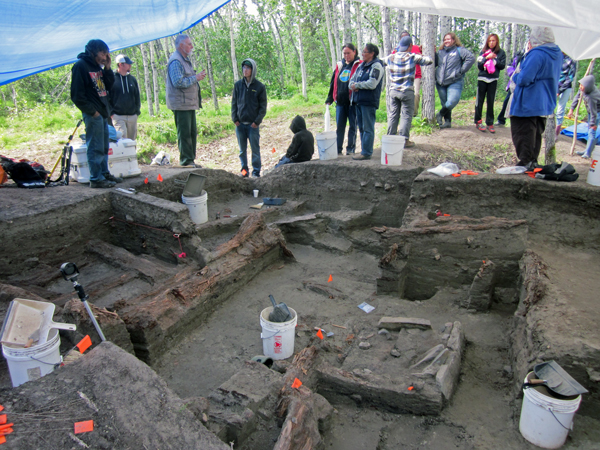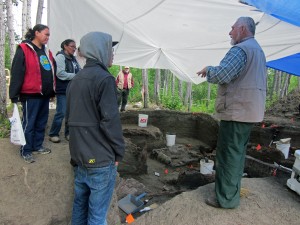
A team of archaeologists from Brown University have uncovered a Native village site in Northwest Alaska that dates from just before first contact.
The village is one of the biggest archaeological sites discovered in the Arctic. Local residents hope the research will tell them more about their ancestors.
It’s a short walk from the banks of the Kobuk River to a mosquito-infested clearing where archaeologists from Brown University have been uncovering the village.
With a white beard and a multi-pocketed khaki jacket, Dr. Doug Anderson points to large depressions in the ground which he says were once houses. He specializes in the pre-history and early history of Northwest Alaska. In his 50-plus-year career as an Arctic archaeologist, Anderson says he’s never seen a village quite like this one with so many houses connected by a web of tunnels.
“In some other areas here we’ve found maybe two houses that are connected by tunnels, but nothing like this,” Anderson said. “And in other areas those houses are really quite small compared to the houses here; these are gigantic houses.”
The dwellings are the size of a typical one-room cabin and dug about four feet down into the earth framed by spruce beams and poles with sod and earth walls and a fireplace at the center.
The depression is dotted with little orange flags mark spots where the crew found artifacts. The dig is located within Kobuk Valley National Park, about 20 or so river miles up the Kobuk from Kiana.
From what he can tell, Anderson believes the village was a regional capital with an estimated population of around 200 people. Through radio carbon dating, researchers found the village dates from the late 1700s or early 1800s, just before first official contact with explorers.
“They may have even been living here when the explorers first came into the Kotzebue Sound,” Anderson said. “There’s a little bit of metal and even some glass beads here before there was any kind of physical European contact.”

Anderson says his crew has a lot of questions about how the artifacts got there. Alaska Natives did not make glass beads or metal. So they had to come from the Outside. They may have come in through from trading with Asian tribes who crossed the Bering Strait or possibly through trading with Interior Alaska Native tribes.
Edward Cleofe is an undergraduate student at Brown who spent the summer working at site. He’s touring a group around the dig. He stands around an excavated house with the group.
“What you see here when you look down is most of the house was underground. They put posts up. You can see a post right there or a little chunk of a post … a post there. So those house posts held up the roof which was made with sod. You can actually see some of the sod posts that we’ve made and or recovered right over there. So these people were living here probably during the winter. Can everyone see the fireplace? You can see the three walls of the stone?,” he said.
As Cleofe explains, researchers found signs that the people who lived in the village kept dogs.
“Does anyone know what coprolites are? That’s a fancy archaeology word for poop. We found a bunch of dog poop right over there full of fish bones and fish scales and fish things. And we’ve also found a lot dog bones in this area. So there’s quite a bit of evidence that says that these people were living very closely with their dogs,” Cleufe said.
Researchers also found two sets of human remains in a one dwelling – one adult male with a broken leg and one young child. Stories from local residents tell of attacks by Indians from the Interior on the village and of possible food shortages. Inupiat Elder Thomas Jackson says that when he was a child, his mother told him that his ancestors had lived at an old village in the area.
“You, you’re a descendant from these people. That’s the first time I’ve heard of this as a child. She says from Hunt River down to Coal Mine area. And that’s where the village, the large village is at,” Jackson said.
Jackson is a member of the Kiana Traditional Council, which is working with Brown University and the Park Service to insure the project moves forward. Elders also told Jackson a few things that had been passed down to them about the people who lived in the village, and they gave him its name.
“They’re at the site called Igliqtiqsiugvigruak which was a large village,” Jackson said. “All what we know about that place, what the people talked about were that of skillful people, a place of strong shamanism acts, a strong dog.”
Kiana resident Debba Barr visited the site; she says learning about the people who could be her ancestors fills her with pride.
“It makes me feel proud,” Barr said. “And it’s a little bit overwhelming when you see all the hard work and all the stuff that we did compared to how we live now.”
She wants to know, “What did they eat? How did they travel? And how did they build the houses?”
That last one is something researchers would like to know too. But curiously, they didn’t find any tools at the site so how they built the subterranean dwellings remains a mystery.
Local residents say they plan to donate their DNA to check against the remains of the people found at the site.
The remains will eventually be returned to tribal leaders for burial.
Daysha Eaton is a contributor with the Alaska Public Radio Network.
Daysha Eaton holds a B.A. from Evergreen State College, and a M.A. from the University of Southern California. Daysha got her start in radio at Seattle public radio stations, KPLU and KUOW. Before coming to KBBI, she was the News Director at KYUK in Bethel. She has also worked as the Southcentral Reporter for KSKA in Anchorage.
Daysha's work has appeared on NPR's "Morning Edition" and "All Things Considered", PRI's "The World" and "National Native News". She's happy to take assignments, and to get news tips, which are best sent via email.
Daysha became a journalist because she believes in the power of storytelling. Stories connect us and they help us make sense of our world. They shed light on injustice and they comfort us in troubled times. She got into public broadcasting because it seems to fulfill the intention of the 4th Estate and to most effectively apply the freedom of the press granted to us through the Constitution. She feels that public radio has a special way of moving people emotionally through sound, taking them to remote places, introducing them to people they would not otherwise meet and compelling them to think about issues they might ordinarily overlook.




